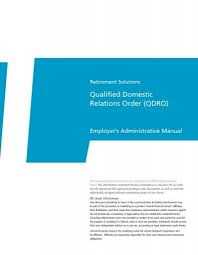What is a Domestic Relations Order (DRO)?

A Domestic Relations Order (DRO) is a legal document that outlines the division of retirement benefits between divorcing spouses or former spouses. It is a court order that directs the administrator of a retirement plan to distribute a portion of the plan participant’s benefits to their ex-spouse.
Importance of a Domestic Relations Order

A DRO is crucial in ensuring that both parties receive their fair share of the retirement benefits accumulated during the marriage. Without a DRO, the retirement plan administrator is not legally obligated to distribute any benefits to the ex-spouse, even if it was agreed upon in the divorce settlement.
Additionally, a DRO provides protection for the plan participant by preventing their retirement benefits from being garnished by creditors or other legal actions taken against the ex-spouse.
Requirements for a Domestic Relations Order

In order for a DRO to be valid, it must meet certain requirements:
- The DRO must be issued by a court with jurisdiction over the divorce or separation proceedings.
- The DRO must clearly identify the retirement plan and the parties involved.
- The DRO must specify the amount or percentage of benefits to be awarded to the ex-spouse.
- The DRO must comply with the rules and regulations of the specific retirement plan.
It is important to note that each retirement plan may have its own set of rules and regulations regarding DROs. Therefore, it is essential to consult with a qualified attorney or a financial professional who specializes in divorce and retirement planning to ensure that the DRO meets all the necessary requirements.
Once the DRO is approved by the court and accepted by the retirement plan administrator, the benefits will be distributed to the ex-spouse according to the terms outlined in the order.
One of the key regulations is that a DRO must comply with the guidelines set forth by the Employee Retirement Income Security Act (ERISA). This federal law establishes standards for private pension plans and ensures that the rights of plan participants are protected.
In addition to ERISA, each state may have its own specific regulations and requirements for DROs. It is important to consult the laws of your particular state to ensure compliance.
One requirement that is common across states is that a DRO must be in writing and must clearly identify the parties involved, including the plan participant and the alternate payee (the person who will receive the benefits). The DRO must also specify the amount or percentage of the benefits that will be paid to the alternate payee.
Another important requirement is that a DRO must be approved by the court. This means that both parties must agree to the terms of the DRO and it must be signed by a judge. Once approved, the DRO becomes a legally binding document.
It is also worth noting that a DRO can only be used to divide retirement benefits that have already been earned. It cannot be used to divide future benefits that have not yet been accrued.
Finally, it is important to understand that a DRO is specific to a particular retirement plan. If a plan participant has multiple retirement accounts, a separate DRO may be required for each account.

Emily Bibb simplifies finance through bestselling books and articles, bridging complex concepts for everyday understanding. Engaging audiences via social media, she shares insights for financial success. Active in seminars and philanthropy, Bibb aims to create a more financially informed society, driven by her passion for empowering others.
